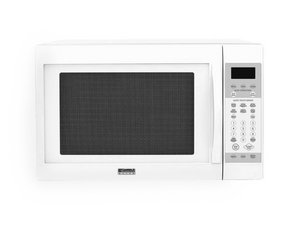Hi @jellynell
I can't find a wiring diagram or a service manual for your model but here's some general information that may help.
A lot of microwave ovens have a Low Voltage (LV) transformer on the control board (this IS the board for your model, click on the 3rd mini image to the left to see the LV transformer and the relays etc) (see part #6 Control parts diagram for location.
Here's an image of a typical wiring diagram that shows how the oven may be wired. This is NOT for your model but it is to show how if the power doesn't get to the LV transformer or if there's a problem on the control board then there's no power for the board to function i.e. dead
@jellynell
That switch you pointed to is not the problem unless there's a loose wire on it
Looking at the schematic you provided, (see image below) there is always power on pin 9 (live) and pin 12 (neutral) of the control board unless the cavity thermostat is operated or faulty, there's a wiring problem or a problem on the control board.
If you follow each of the wires on the diagram, back from the two pins you will see that they get to L1 and N without having to pass through a closed switch, "except" the cavity thermostat which is normally closed. The power is connected to other switches but only gets through when they're operated either by the door being closed (interlocks) or the temp thermostat operating
(click on image)
@jellynell
If there's power on pin 9 but no Neutral on pin 12 no current will flow through the LV transformer. This is the power that is used to supply the control board.
The control board switches 120V AC power but the relays etc don't operate at that voltage. They all use a lower voltage that is supplied by the LV transformer on the board, as long as it has power being supplied to it that is ;-)
You may have to do point to point continuity testing along the Neutral path.
Did you test the power cord from the plug's Neutral prong to where the Neutral wire is terminated in the oven, you didn't say? If not try that first, if may be a faulty power cord. Try flexing the cable, especially near the plug and check if there's continuity on the Neutral wire or if it "comes and goes" as you flex. It may be fractured
With the power disconnected, (also see safety advice below) place one Ohmmeter probe on the Neutral prong of the power cord plug, and then use the other Ohmmeter probe to check for continuity on the path i.e. start at pin 12 on the control board - if no good, then on the white wire of the primary interlock switch, if no good then on one side of the cavity thermostat. If still no good try the other side (they're both white wires so there's one each side and you don't know where it comes from - switch or prong). If you get continuity on one side of the thermostat, but not the other it is faulty.
See link above for replacement part.
Be safety aware - discharge the HV capacitor before testing. It can store >5000V DC for months even if the power has been disconnected for this length of time. This amount of voltage can seriously injure you.
War diese Antwort hilfreich?
Bewertet
Rückgängig machen
Bewertung
1
Abbrechen
Schau durch den Thread, bis du den richtigen Platz für diesen Kommentar gefunden hast. Klicke dann auf "Den Kommentar diesem Post zuordnen", um ihn zu verschieben.

 1
1 
 366
366  1,4 Tsd.
1,4 Tsd. 


